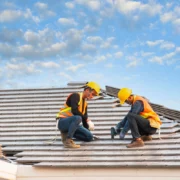When you need access to elevated areas like rooftops, roof hatches are one of the best utilities you can lean on. However, roof panels alone don’t guarantee a secure and safe landing at the highest point of your building.
Hence, you need to attach additional sturdy components that will enable your hired cleaning, repair, maintenance, or other specialists to do their tasks efficiently and safely.
In this blog post, you’ll learn the different roof hatch lift assistance you can install with your equipment. Make sure to take note of each component’s characteristics, so you can appropriately pick the right safety tool for your building’s roof:
1. Railings
Roof hatch railing systems, also known as guardrails, are fixed building safety companions that firmly assist workers when working with heights. These are handy protection barriers as they require no training for utilization nor demand them to wear fall protection equipment.
Moreover, they are visible enough to install in various precarious areas, like roofs, balconies, stairwells, or open holes. You can utilize the guardrails as an efficient alternative if the following isn’t applicable around the mentioned elevated sites:
- covers
- floors
- walls
When attaching a railing system to a commercial establishment, you must deeply ponder its length. Consider also the weather and other environmental factors that can affect the performance of the guardrails.
Make sure you’re using the correct and good-quality fasteners to ensure your railings’ sturdiness. Lastly, you must avoid reusing old construction materials when installing. Remember that your crew’s safety relies on this.
2. Safety gates
Safety gates in an industrial setting are more suitable to attach as they reduce fall risks or further relevant workplace injuries in elevated areas and stairway openings. Below are other indications that your industrial facility calls for safety gate installation:
- You often leave your loading docks open.
- Your building contains multiple mezzanines or stairways
- Your business operates with harmful equipment.
- Your entire structure has many ladders, platforms, and floor holes.
Furthermore, it would be best to consider installing safety gates if a construction or renovation occurs in your facility. Having protective measure utilities, like safety gates, also boosts your chance of passing the annual Occupational Safety and Health Administration (OSHA) inspection.
3. Lift and Lock
Lift and lock is another convenient safety measure that allows you to cautiously control your establishment’s roof hatches, preventing crewmates’ injuries. With this practical tool, you can easily open, close, lock, and unlock while standing at the ladder’s base without climbing up and down, reducing the potential for workplace accidents.
You can move the opening seamlessly by using a simple hand-operated winch connected to the lifting arm attached to the roof hatch’s top covering. What’s more amusing about this tool is that it requires no electricity or battery, making it an energy-saving alternative to implement safety measures within your building’s elevated areas.
4. Fixed ladder lifeline
Fixed ladder lifelines are unique safety companions that protect personnel vertically, securely preventing falls as they ingress and egress out of the elevated site.
It’s a tool you can retrofit on your ladders and serve as a moving lifeline connector among high-rising establishments, water and cellphone towers, wind turbines, silos, and industrial installations.
Compared to cage systems, it’s a cost-effective protector requiring less expensive fabrication, application, and maintenance. More importantly, it’s flexible to meet the location demands, so the product can easily adapt whether you need a ladder lifeline system inside or outside your building, in a straight or curved configuration.
Before installation, take some time to review the standard OSHA regulations regarding fixed ladders. This way, you can successfully pass the inspection every year, certifying that your establishment is safe to work in, which can lure more potential industry applicants and boost the needed workforce for your company.
Wisely invest in roof safety
Partnering your roof hatches with additional safety equipment that can secure authorized personnel’s safe climbing in and out of the roof entry point is an essential and wise investment, helping you to prevent tragic accidents.
Business owners are also responsible for safeguarding their employees, especially when working in elevated areas and putting their life at risk.
Railings, safety gates, lift and lock, or fixed ladder lifelines are important construction and industrial safety installation, guaranteeing workers’ protection from any harm. Ensure that the products you’re attaching are OSHA-compliant to avoid failures and inefficiency.










Comments